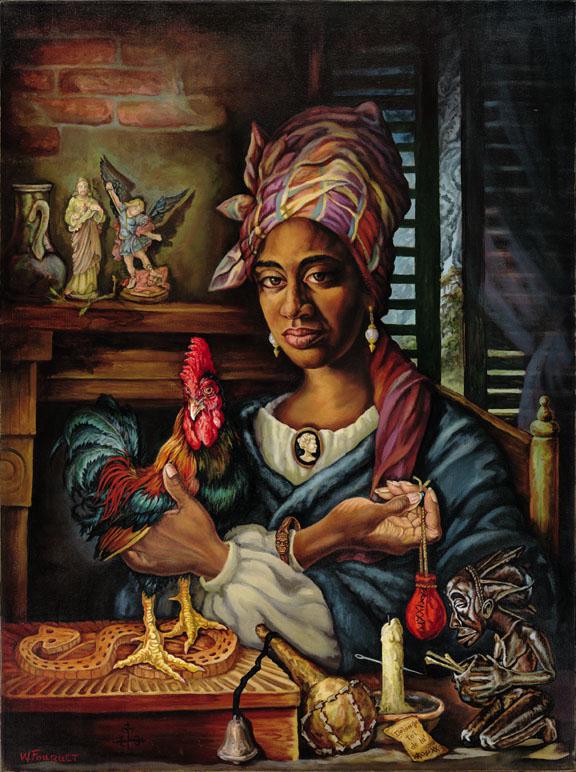

Dimitri Fouquet's Marie LaVeau
![]()
This new and wonderfully symbolic poster of the Madame L. I purchased through a very nice woman in N'awlins by the name of Lady Felicia who owns and operates the Witches Closet. This exciting new addition to my Madame L. altar adds a great icon of symbology. The rooster characterizes the art of using the fowl for a service offered by Hoodoo workers. The service was for the trained fowl to go about a client's yard and scratching up to the surface dreaded gris gris someone placed cleverly on the premises of it's victim. It appears the woman in the portrait is holding a gris gris bag and perhaps is training this rooster for this very service. The rooster stands on a wooden box with the carved image of a snake with the sunburst surrounding it. This image is a symbol of Dambala, a name of a haitian god known as a loa or lwa. There are stories of Madame L. possessing a snake she named Grand Zombi which she was suppose to keep in a box of sorts. I believe the artist characterizes this to be the box which housed the serpent. Next to the box, there is the voodoo rattle or asson. This item is a tool used commonly by the Vodu Priest, Vodu Priestess, the Bokor and Voodoo Witch, (sosye). These voodoo rattles or assons, are made from a gourd commonly known as the Dipper Goard variety. A net of assorted colored beads along with snake vertebra are woven on the outside of the gourd and the rattle is finished off with a bell being attached to the end of it's handle. It is understood that the older rattles were made with a beaded net woven entirely of snake vertebra, this provides a clue to the one in the portrait above as a dated tool. The candle with a sharp darning needle through it charaterizes a spell being cast, the parchment paper below the candle is inscribed with the intent of it's purpose. The wooden figure is holding a container of sorts which looks to me to be the bones from chicken wings. These bones are often used in making crosses for protecion, however it is not really clear what their purpose is. Marie LaVeau is portrayed wearing a tignon which was once required by law for women of color to wear. The blue shawl that is being worn also is symbolic the woman in the portait is Madame L. as there are many stories about Marie LaVeau 's shawl. On the mantelpiece there are two statues, one of the Sacred Heart of Jesus and the other is of St. Michael. This would relate to Marie LaVeau's Catholic beliefs that would remain with her all through her life span.